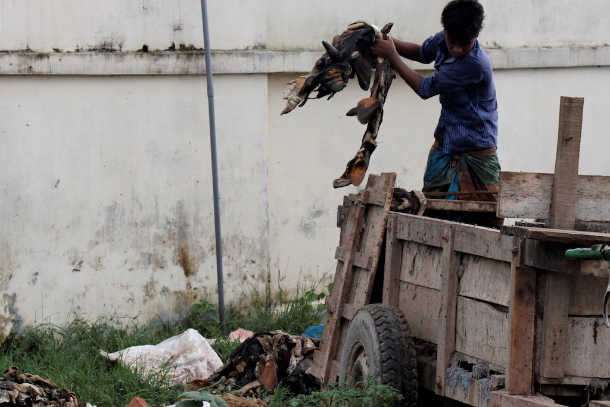
A tannery worker dumps waste from a pushcart in the Savar suburb of Dhaka, where the Bangladeshi tannery industry was relocated last year. The industry has been accused of polluting an adjacent river and the environment due to lack of oversight and inadequate waste treatment. (Photo by Stephan Uttom/ucanews.com)
Bangladesh's relocated tanning industry, which supplies footwear and clothing companies around the world, is at the center of a new pollution furore.
A promised effluent treatment plant at a sprawling leather processing estate has so far failed to come into operation.
In the past, there were reports of big brand name companies using leather from Bangladesh.
However, activist groups who investigated the trade say many such Western companies took swift action to resource their supplies of leather and leather goods in the face of revelations of industry environmental and health abuses in Bangladesh.
Nonetheless, there remains a high degree of secretiveness in relation to manufacturing companies that continue to buy leather from Bangladesh as well as retailers who sell the end products.
Ongoing serious problems in Bangladesh's leather industry are expected to turn a spotlight back on both abuses and the international leather trade.
Environmentalists are now accusing about 155 factories at an industrial estate 25 kilometers from capital Dhaka of putting the environment and public health at grave risk.
After nearly two decades of court cases and protests, as well as pressure from foreign buyers, the tanneries in 2017 shifted from the Hazaribagh area of Dhaka to the new site on the banks of the Dhaleswari River.
Amid lax regulation, Hazaribag had come to be listed as one of world's most polluted and unlivable places, with the nearby Buriganga River almost devoid of fish and other aquatic life.
Now Bangladesh environmental activist group Poribesh Andolon alleges that inadequate effluent treatment from the relocated tanneries still poses a health and ecological threat, including to the arability of farming land.
"In the past, chemical waste was discharged into the Buriganga River and now it is being dumped into the Dhaleswari," the organization's joint secretary, Sahrif Jamil, told ucanews.com.
The treatment plant promised as part of the relocation is still not in operation, Jamil added.

A view of the bank of the Dhaleswari River close to a garbage dump for the tannery industry in the Savar suburb of Dhaka. (Photo by Stephan Uttom/ucanews.com)
Rokon-uz-Zaman, a villager and tea stall owner, said the tanneries were becoming a nightmare for his community. For example, tin-roofed houses developed holes and quickly collapsed.
He said villagers attributed this to myriad chemicals, including different salts, used in the animal hide tanning process.
"This river was beautiful," he said of the Dhaleswari. But since the arrival of the tanneries the water color had changed and few people came to the river for recreation as the tanneries dumped toxic waste into it at night, he said.
Nur-uz-Zaman, 60, a tannery worker for more than 30 years, predicted that in future the Dhaleswari will become as polluted as the Buriganga River.
Shaheen Ahmed, chairman of the Bangladesh Tanners' Association, the main commercial body, said the treatment plant and monitoring were government responsibilities. "If we see any irregularities, we inform the authorities," he said.
M.A. Hannan, a deputy manager of the state-run Bangladesh Small and Cottage Industries Corporation, admitted that functioning of the effluent plant had been delayed.
Due to various reasons, including a skills shortage and monsoon rains, it had not been possible as yet to complete the plant, he said.
"The work is in progress and we hope to finish it in the quickest possible time," Hannan told ucanews.com.
Bangladesh exports leather and leather goods worth about US$1 billion a year out of a global market valued at US$215 billion, according to the Bangladesh Export Promotion Bureau.
In the Asian region, Bangladesh's biggest customers are in China, South Korea, India, Nepal, Japan and Australia.
In the West, Italy, Belgium, Spain, Germany, Poland, France, the U.K., the U.S. and Canada are the primary export destinations, according to the Asia Pacific Leather Fair, a sourcing hub for leather and leather goods.


